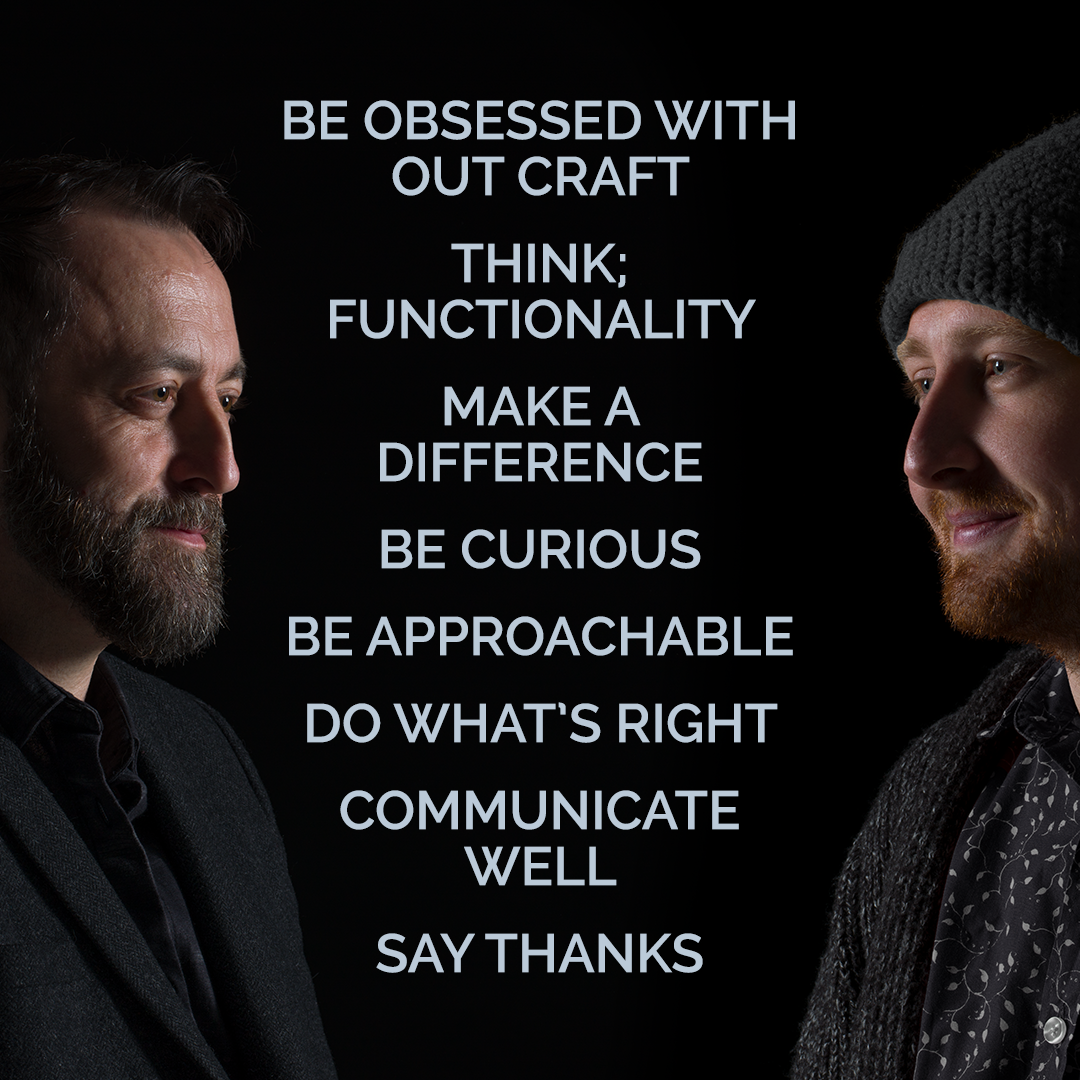
Brand Values
Our Values
If you’ve ever done it, can you remember the values your business settled on? Are they really a true part of your daily life in work, have they made their way into the culture of the firm? It’s probably not too much of a stretch to say that too often a ‘values’ project can be great fun, diverting, but simply a case of ticking that particular box: “yeah, we’ve done a value/vision/cultural statement” … tick!
As a test… we love a good test… no pressure… ask your colleague; “what are our company’s values?”. Then watch as said colleague digs around in the filing cabinet/drawer/floor/bin for that pesky sheet with it all laid out on.
“Yeah, we’ve done a value/vision/cultural statement”
A little while ago we decided that we too needed to revisit our existing brand values and then hopefully move that into a full cultural statement, which we’d been promising to do, but not quite managed to get to (same problem as my neighbours car, he’s a mechanic and his car leaves the neighbourhood with the fan belt protesting in a piercingly loud squeal most days…).
Anyway, I digress. Straight away we said anything we did had to form and also inform how and what we do on a daily—and longer-term—basis. As a smaller firm, we just don’t have much spare time to play with, so we must always consider what will be truly useful to us and our clients.
Brand values are fantastic ways of keeping advertising copy on track, ensuring your website copy matches up with the other elements of your marketing collateral and much more.
One of my favourite approaches to brand values is to think about what we would be if we were a retail brand (or car brand, or appliance brand) and why. This gives a pretty quick filter on how you currently see yourself and how you’d like to see yourself. Then you look at the values of that brand and see what it is about them that draws you. That’s gold right there!
Who Leads?
Of course, further to this is whoever creates the culture in your organisation is the main lead here. Whoever has the power to influence the culture on a day to day basis is such a significant part of this. Brand values and by extension cultural statements must be seen right through, I can’t emphasise that enough.
Once we’d laid out who we felt we were and who we’d like to be, we examined why that was the case. We could then start to see the sorts of values that are synonymous with that brand. As typical examples: Apple have historically been synonymous with a design led approach, as are brands such as Porsche, Nike and so forth. John Lewis are known for their approach to customer service (and you can see these values come under pressure in times of difficulties). Netflix were known as innovators in their market—and killed Blockbuster in the process (where now for them though?).
Out of this work we can then draw down words that encapsulate a brand. They usually take the form of ideas such as: Human, Approachable, Detail Oriented, Passionate, Obsessed, Client first, Joy, Ego-free, Workmanship, Craft, Listening, Imagination and so forth… (at least for us these were a selection of terms that came out of the work).
We then laid these into four categories: Passionate, Purposeful, Style, and Human. These don’t form the main values yet but help draw the disparate sets of words into more manageable sets.
At Caffeine Creative we turn ideas into reality and help transform the performance of your marketing materials. By crafting excellent graphic design, for both print and web applications, we can help you achieve the results you want in revenue generation, customer retention and better communication. With our wealth of knowledge and experience we will guide you through what you can achieve from print and web realising your true potential.
We understand that each audience is different and needs a specific approach. We take time to talk to you about the project you are working on and what goals you want to attain. We work a little bit differently to most design agencies in not starting with aesthetics or applying a style we might have already but doing some important ground work in collaboration with you on the purpose of your brief and then crafting a result that hits the spot perfectly.
We have many years’ experience and proven success in working with small and large companies and organisations. We feed all that valuable experience into your next project whether it’s a stylish new stationery set, website, catalogue, or advert. You name it, we punch well above our weight at a price that is realistic.
Yeah, we’ve done a value/vision/cultural statement
Once we had our wide set of values laid out clearly, we wanted to widen things out and create a cultural statement we can live by.
The really important part of this for all companies or organisations, is that believe they can implement it. It’s imperative to distil those values, along with how they work, down into a concise statement or a shorter list. One that could actually be remembered and used. Then it stands a chance of becoming part of your culture.
Cultural Statement
Definition of a Cultural Statement: “The set of shared attitudes, values, goals, and practices that characterizes an institution or organization.”
An approachable way to start to form a cultural statement is to breakdown the segments into four key categories:
• Attitudes (The personal bit…)
• Values (What are the values we want associated with our company?)
• Goals (What are we aiming for?)
• Practices (How things get done)
You’ll, like us I imagine, end up with a massive spiralling list associated with the above. Such a list would be impossible to remember. You should have lots of broad scope ideas under each heading such as: no ‘small print’, help other develop, allow staff a feedback channel, be an observer, walk in other people’s shoes etc (these are drawn out of the initial values discussion and list). The trick now is to pull that down to a maximum (and if you can do it in less that’s even better) of 10 points or a paragraph with a few bullets perhaps (or even just one short line) that encapsulate all these ideas into a more succinct set.
Our massive list (and it was massive) was tough to bring down. It contained many statements that could actually be summed up in much more pithy language. After a fair bit of work we got to this:
1. Do what’s right, always
2. Create function and then form
3. Be approachable
4. Be curious
5. Be obsessed with our craft
6. Make a difference
7. Communicate well
8. Say thanks…
Day to Day
So, this is a (believe it or not) very cut down discussion of what we went through, and what we went through then informed our copy, our images, our marketing campaign, and our every day. It informs how we respond to our clients and each other. It keeps things consistent and, in a tangible way, measurable.
One thing we noticed was this typical example of a conversation in the office…
Designer 1: “What should I do in this situation?”
Designer 2: “What’s the right thing for the client?”
Designer 1: “X”
Designer 2: “Is there a strong reason not to do X?”
Designer 1: “A bit of a cost in time to us”
Designer 2: “That’s fine, let’s just do the right thing for the client…”
That was number 1 in the list, “Do What’s Right, Always”.
This is a very shortened outline of how we approach brand values for ourselves and our clients. If you’d like to find out more about how we can help your business focus on its values, please get in touch with us today.
The Caffeine Creative team…
We’re a little obsessed with crafting effective designs for print and web
